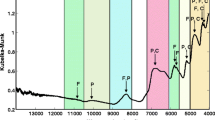Abstract
Evaluations of daily nutrient intakes with practical accuracy contribute not only to public but also to personal health. To obtain accurate estimations of nutrient intake, chemical analyses of a duplicate sample of all foods consumed are recommended. But these analytical methods are expensive, time consuming, and not practically applicable for field surveys dealing with numerous food samples. To solve this problem, a new rapid and simple method of estimating nutrients is developed here. Elemental compositions of cooked foods were examined using a high speed and high performance carbon, hydrogen, and nitrogen autoanalyzer, and the results showed good reproducibility. A significant correlation between Kjeldahl’s and the autoanalyzer methods was observed in the nitrogen measurement (n=20; r =0.999; p< 0.001), and very good agreement was observed between the methods. Therefore, the nitrogen amount obtained by the autoanalyzer was used for the estimation of the protein proportion in the cooked foods. The fat and carbohydrate proportions estimated by the new method correlated with the values obtained by the chemical method (p< 0.001 each). There were also good agreements of fat and carbohydrate proportions between the chemical and the new estimation methods. According to these results, the new, rapid and simple estimation method established in this study should be applicable to nutritional research.
Similar content being viewed by others
References
Burke BS. The dietary history as a tool in research. J Am Diet Assoc 1947; 23: 1041–6.
Goldberg J. Nutrition and health communication: the message and the media over half a century. Nutr Rev 1992; 50: 71–7.
Drewnowski A. Dietary fats: Perceptions and preferences. J Am Coll Nutr 1990; 9: 431–5.
Eck LH, Klesges RC, Hanson CL, Slawson D, Portis L, Lavasque ME. Measuring short-term dietary intake: Development and testing of a 1-week food frequency questionnaire. J Am Diet Assoc 1991; 91: 940–5.
Ulijaszek SJ. Estimating energy and nutrient intakes in studies of human fertility. J Biosoc Sci 1992; 24: 335–45.
Posner BM, Borman CL, Morgan JL, Borden WS, Ohls JC. The validity of a telephone-administered 24-hour dietary recall methodology. Am J Clin Nutr 1982; 36: 546–53.
Acheson KJ, Campbell IT, Edholm OG, Miller DS, Stock MJ. The measurement of food and energy intake in man - an evaluation of same techniques. Am J Clin Nutr 1980; 33: 1147–54.
Bingham SA, Gill C, Welch A, et al. Comparison of dietary assessment methods in nutritional epidemiology: weighed records v. 24h recalls, food-frequency questionnaires and estimated-diet records. Br J Nutr 1994; 72: 619–43.
Marshall MW, Iacono JM, Young CW, Washington VA, Slover HT, Leapley PM. Composition of diets containing 25 and 35 per cent calories from fat. J Am Diet Assoc 1975; 66: 470–81.
Medlin C, Skinner JD. Individual dietary intake methodology: A 50-year review of progress. J Am Diet Assoc 1988; 88: 1250–7.
Dwyer JT. Future directions in food composition studies. J Nutr 1994; 124(suppl): S1783–8.
Pekkarinen M. Methodology in the collection of food consumption data. World Rev Nutr Diet 1970; 12: 145–71.
Marr JW. Individual dietary surveys: purposes and methods. World Rev Nutr Diet 1971; 13: 105–64.
Pennington JAT, Wilson DB. Daily intakes of nine nutritional elements: Analyzed vs. calculated values. J Am Diet Assoc 1990; 90: 378–81.
Helrich K. Official methods of analysis of the association of official analytical chemists, 15th edition, pp.342. Arlington, VA: Association of official analytical chemists; 1990.
Helrich K. Official methods of analysis of the association of official analytical chemists, 15th edition, pp.770–1. Arlington, VA: Association of official analytical chemists; 1990.
Abdulla M, Aly KO, Andersson I, et al. Nutrient intake and health status of lactovegetarians; chemical analyses of diets using the duplicate portion sampling technique. Am J Clin Nutr 1984; 40: 325–38.
Helrich K. Official methods of analysis of the association of official analytical chemists, 15th edition, pp.341. Arlington, VA: Association of official analytical chemists; 1990.
Ishiyaku-shyuppan. Japan standardized food composition table, 4th edition, pp.295–302. Tokyo: Ishiyaku-shyuppan; 1983.
McArdle WD, Katch FI, Katch VL. Exercise physiology. Energy, nutrition, and human performance, Second edition, pp.95–104. Philadelphia, PA: Lea & Febiger; 1986.
Bland JM, Altman DG. Statistical methods for assessing agreement between two methods of clinical measurement. Lancet 1986; February 8: 307–10.
Brennan P, Silman A. Statistical methods for assessing observer variability in clinical measures. BMJ 1992; 304: 1491–4.
Goranzon H, Forsum E, Thilen M. Calculation and determination of metabolizable energy in mixed diets to humans. Am J Clin Nutr 1983; 38: 954–63.
Borrelli R, Simonetti MS, Fidanza F. Inter- and intra- individual variability in food intake of elderly people in Perugia (Italy). Br J Nutr 1992; 68: 3–10.
Author information
Authors and Affiliations
Rights and permissions
About this article
Cite this article
Kumae, T. Development of a new simple estimating method for protein, fat, and carbohydrate in cooked foods.. Environ Health Prev Med 4, 205–211 (2000). https://doi.org/10.1007/BF02931259
Received:
Accepted:
Issue Date:
DOI: https://doi.org/10.1007/BF02931259




